汉英比较翻译教程 第14单元
左彪-英汉对比与翻译(全)

Two Types of Transfer
• Negative Transfer (负迁移) Errors arise from analogy. 类推会产生错误。 • Positive Transfer (正迁移) Errors decrease by analysis. 分析能减少错误。
We could turn negative transfer (interference) into positive (facilitation) by making analysis on differences between the two languages and arouse the learner‟s awareness of avoiding or reducing errors from analogy. 我们可以通过分析两种语言的差异,提高学生避免 或减少类推错误的意识,把负迁移(干扰)转化为正迁 移(促进)。
人在阵地在。 The position will not be given up so long as we are still living. 人无远虑, If one has no long-term considerations, 必有近忧。 he will find trouble at his doorstep.
English-Chinese Contrast and Translation 左飚
英 汉 对 比 与 翻 译
English-Chinese Contrast and Translation
左 飚
上海建桥学院 上海海事大学 zuobiao212@
欢迎光临
英 汉 对 比 与 翻 译
Chinese
Lacking inflection in the strict sense 缺少严格意义的 形态变化 老师们、同学们 我的爸爸、你的妈妈 认真的态度、 认真地学习
英汉汉英视译教程ppt课件
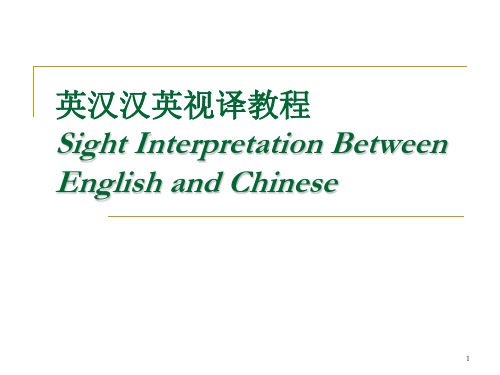
译员在书写译文之前往往已经对原文进行了视译,
而且很可能不止一次地视译原文。这对口译译员
来说更是如此。很多情况下,书面发言稿是在活
动开始前的最后一刻才迟迟送达译员手中。译员
根本没有充裕的时间事先将其翻成译文,而只能
在讲话人念稿的同时匆匆浏览一下文章的内容,
因此视译是所有从事口译工作者的基本功。交替
传译和同声传译中的视译一般有以下几种情形:
号不够周全, 都会造成译文逻辑混乱,漏洞百出。
可见译员在确保信息处理质量的前提下,应不断
提高处理信息数量的能力。视译信息数量的处理
能力是视译信息质量处理能力的组成部分, 这是
视译的时效性决定的。
16
序言
3. 补充遗漏信息。一旦遗漏了重要信息,无
论是词语还是语句,可另外补加一句译文,补足
其意。但是,除非万不得已,应尽量避免在句子
了从视译角度提供了充分的解析之外,我们还同时
从其他角度提出了具有实用性和探索性的翻译见解。
我们殷切希望本教材的问世能够引发业界师生们的
深刻思考,使当前我国视译或口译教学效率低下的
现实有所改观,从而开创外语教学的新局面。
鉴于作者学识和经验所限,本教程定有诸多缺
憾,甚至谬误之处,诚请各位同仁不吝赐教。谨此
果适度迁就时间便是唯一的出路。
11
序言
2. 语意为先,语言为后。视译翻译效果包含
两个方面:语言效果和语意效果,语言效果和语
意效果俱佳是最理想的境界。但是,由于种种因
素作祟,语言效果和语意效果常常不能两全,此
时只能适度牺牲语言效果,以便最大限度地追求
译文语意的质量。
12
言
3. 实词为重,虚词为轻。视译时的阅读和思
英汉互译教程-英汉语言对比课件

有些语言学家用植物来作比,把英语句子 的结构称为“葡萄型”结构,意为在短短 的主干上派生出长长的枝蔓和丰硕的果实; 汉语句子因为很少叠床架屋,节外生枝, 而是一个短句接一个短句地往下延伸,因 此被称为“竹竿型”结构。
基本方法: 英译汉时,往往要先分析句子的结构,形 式,才能确定句子的功能、意义; 汉译英时,往往要先分析句子的功能、意 义,才能确定句子的结构、形式
英汉词汇对比
1) equivalents microwave supermarket right-wing keyboard nuclear weapons chain reactions cold war open secret The U. S. State Department The Pacific Ocean
英汉互译教程
---英汉语言对比
1
Content
教学目的:旨在让学生了解英汉词汇, 语言结构以
及思维方式方面的差异。
教学内容:
1. 英汉词汇对比
2. 英汉语言结构对比 1) 重形合重意合 2) 前重心后重心 3) 主体与客体
3. 英汉思维方式对比
对于中国学生最有用的帮助是让他认识英 语和汉语的差别。 ——吕叔湘 You could know your own language only if you compared it with other languages. ——Engels
那是个天气晴朗、金黄可爱的秋天,对于 那些在和平时期的秋天树叶再度转黄之前 将要失去青春、有的要失去生命的人们是 一个动人的送别。 那是个天气晴朗、金黄可爱的秋天,动人 的秋色为那些青年们送别。待到站后和平 时期,黄叶纷飞的秋天再度来临时,当日 的青年已经失去了青春,有的失去了生命。
英汉语比较与翻译2 12年3月14日
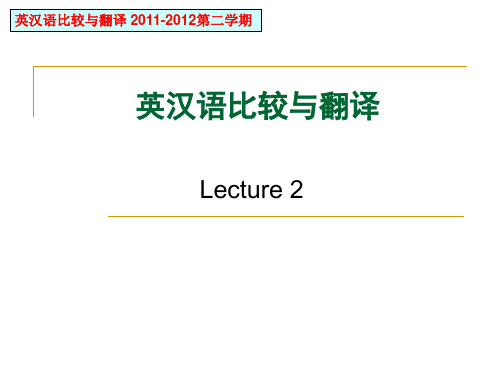
英汉语比较与翻译 2011-2012第二学期
英语中 -fy, -ize 常 常翻译成 汉语中“ 化”,如 modernize, beautify。 “- 化”在汉语中是相当能产的一个后缀,可加在形容词和 名词后,表达某种使役关系,如“工业化”、“欧化”、“西 化”。但汉语中由“化”构成的词可以直接用作动词的并不多 ,特别是由名词加“化”构成的词,如一般不说“机械化农业 ”、“现代化中国”,而是说“使农业实现机械化”、“使中 国实现现代化”。
“子”作为后缀时,加在名词、形容词或动词词素后缀合成 名 词 , 翻 译 成 英 语 往 往 并 不 是 一 个 派 生 词 :
帽子 旗子 命根子 胖子 矮子 垫子 掸子 骗子
hat flag lifeblood fatty shorty; shortie cushion, mat duster swindler
英汉语比较与翻译 2011-2012第二学期
英汉语比较与翻译
Lecture 2
英汉语比较与翻译 2011-2012第二学期
Comparison of Words and Translation (1) 词的比较与翻译
Word Formation 构词方式
英汉语比较与翻译 2011-2012第二学期
由于汉语对词缀的认识不一致,数量多少难以确定。 赵元任(1968)78个 任学良(1981) 68个 滕永超(1999) 100 魏志成 (2003) 164个
英汉语比较与翻译 2011-2012第二学期
相对而言,英语词缀数量比较一致,一般来说,英 语有词缀300左右。英汉词缀的差别还体现在: 1. 英语词缀有明显的词形特征,看上去就是词缀, 而汉语的词缀和词并没有区别。 英语词缀是黏着词素,不能独立使用,只能附加 在词或词根上参与构词。有的几乎没有词汇意义, 只是词性的标记,如后缀-ly,-ness,-ion等。
14.修辞翻译讲义-辞格比较与翻译方法
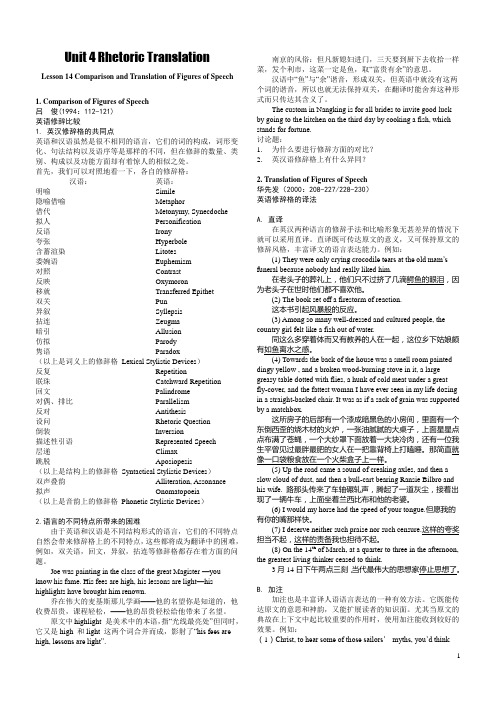
Unit 4 Rhetoric TranslationLesson 14 Comparison and Translation of Figures of Speech 1. Comparison of Figures of Speech吕俊(1994:112-121)英语修辞比较1. 英汉修辞格的共同点英语和汉语虽然是很不相同的语言,它们的词的构成,词形变化、句法结构以及语序等是那样的不同,但在修辞的数量、类别、构成以及功能方面却有着惊人的相似之处。
首先,我们可以对照地看一下,各自的修辞格:汉语:英语:明喻Simile隐喻借喻Metaphor借代Metonymy, Synecdoche拟人Personification反语Irony夸张Hyperbole含蓄渲染Litotes委婉语Euphemism对照Contrast反映Oxymoron移就Transferred Epithet双关Pun异叙Syllepsis拈连Zeugma暗引Allusion仿拟Parody隽语Paradox(以上是词义上的修辞格Lexical Stylistic Devices)反复Repetition联珠Catchward Repetition回文Palindrome对偶、排比Parallelism反对Antithesis设问Rhetoric Question倒装Inversion描述性引语Represented Speech层递Climax跳脱Aposiopesis(以上是结构上的修辞格Syntactical Stylistic Devices)双声叠韵Alliteration, Assonance拟声Onomatopoeia(以上是音韵上的修辞格Phonetic Stylistic Devices)2.语言的不同特点所带来的困难由于英语和汉语是不同结构形式的语言,它们的不同特点自然会带来修辞格上的不同特点,这些都将成为翻译中的困难,例如,双关语,回文,异叙,拈连等修辞格都存在着方面的问题。
【英汉比较与翻译课件】

第一章植物篇一、中西植物词文化意义的比较与翻译(一)汉语中喻君子的植物:梅兰竹菊1、梅plum汉语中,梅花因严寒时盛开,多与高山幽谷为伴,香远益清,因而是坚强、纯洁、刚正不阿等品性的象征。
梅妻鹤子take a plum tree for one’s wife and cranes for children – a lofty scholar梅花傲雪(like red)plum blossoms defying frost and snow梅在国外种植甚少,“梅”“李”混称plum,无此象征意义。
2、兰orchid汉语中用“兰”象征离尘脱俗、高雅纯洁的人品节操。
英语中orchid象征“富饶”、“丰产”和“精雅”,也象征“美丽”。
兰薰桂馥as fragrant as orchids and cassia兰芝之室The air in the room was filled with fragrance of orchid and jasmine.兰质蕙心pure heart and spirit兰摧玉折premature death of a virtuous/ gifted individual; die a hero’s death3、竹bamboo汉语中竹因冬夏常青、中空有节、质地坚硬等特性而被赋予正直、廉洁、有气节等品格。
bamboo在英语中无特别含义,一般英美人对竹子的生长了解甚少,因此竹子译成英语时要灵活处理。
雨后春笋spring up like mushroom; mushroom after rain胸有成竹have a well-thought-out plan; with complete confidence; have/keep a card up (in) one’s sleeve竹篮打水一场空draw water with a bamboo basket; achieve nothing; all in vain竹筒倒豆子pour beans out of a bamboo tube –withhold nothing; make a clean breast of sth.; hold nothing back青梅竹马green plum and a bamboo horse—a girl and a boy had an innocent affection for each other when they played together in childhood; companion in youth势如破竹meet with no resistance敲竹杠比喻利用别人的弱点或以某种口实为借口来索取财物pay through the nose (被)雨后春笋s pring up like mushrooms4、菊chrysanthemum又叫“黄花”。
英汉互译简明教程(第二版)课件14 第四篇 专有名词的翻译

世界著名企业名称和品牌通常都有约定俗成的译法,其 中很多采用的是音译,如: • Nike 耐克 • Michelin 米其林 • Cadillac 凯迪拉克 • Phillips 飞利浦 • Maxwell 麦斯威尔
专有名词英译汉
3. 机构名称的翻译 3.2 意译
• 如:中国北京清华大学28号楼502室,应翻译为Room 502, Dormitory Building 28, Tsinghua University, Beijing, China。
• 中文地址翻译成英文的顺序是:X室、X号、X路/街、X区 /县、X市、X省,然后是中国。
3.中文地址的英译
其汉英对照如下:
1. 汉语地名的翻译方法
汉语地名翻译通常采用汉语拼音加直译的方法。 1.1 一般专名加通名构成汉语地名的翻译
这类情况通常将专名译作汉语拼音,然后再意译通名,例如: • 珠海市 Zhuhai City • 王府井商业街 Wangfujing Shopping Mall • 青藏高原 the Qinghai-Tibet Plateau • 四川盆地 the Sichuan Basin • 京杭运河 the Beijing-Hangzhou Canal
香山 Xiangshan Hill, 象鼻山 the Elephant Hill • Peak (山峰)
莲花峰 the Lotus Peak, 独秀峰 the Singular Beauty Peak
1. 汉语地名的翻译方法
1.5 通名为不同汉字的同一种译法 与前面相反,不同的汉字在很多情况下可英译为同一个单 词。譬如“江、河、水、溪”都统一英译为river,如:
• 长江 the Yangtze River • 黄河 the Yellow River • 珠江 the Pearl River • 古田溪 the Gutian River
英汉翻译教程--汉英语言对比【精品-doc】

英汉翻译教程--汉英语言对比第一部分汉英语言对比翻译教学和研究的经验表明:翻译理论和技巧必须建立在不同语言和文化的对比分析基础上。
英汉互译的几项基本原则和技巧,如选词(Diction)、转换(Conversion)、增补(Amplification)、省略(Omission)、重复(Repetition)、替代(Substitution)、变换(Variation)、倒置(Inversion)、拆离(Division)、缀合(Combination)、阐释(Annotation)、浓缩(Condensation)、重组(Reconstruction),以及时态、语态、语气、习语、术语等的译法,都集中地体现了英汉的不同特点。
机器翻译是让计算按照人们所制定的程序和指令进行不同语言的对比转换,也离不开对比分析。
翻译之所以困难,归根结底是因为语言差异和文化差异。
因此,对比、分析和归纳这些差异,便是翻译学的重要任务。
不同语言的对比分析不仅有利于教学和翻译,也有助于语言交际。
通过对比分析,人们可以进一步认识外语和母语的特性,在进行交际时,能够有意识地注意不同语言各自的表现方法,以顺应这些差异,防止表达错误,避免运用失当,从而达到交际的目的。
(连淑能,《英汉对比研究》)纪德是最理解莎士比亚的法国作家之一。
在他看来,“没有任何作家比莎士比亚更值得翻译”,但同时,“也没有任何作家比他更难翻译,译文更容易走样”。
纪德对莎士比亚的理解是双重的,既是精神的,也是语言的。
他在与莎士比亚的相遇与相识中,经历了一系列的考验。
对他在翻译中经历的这番历史奇遇,他曾在为七星文库出版的《莎士比亚戏剧集》撰写的前言中作了详尽的描述:描述了两种文化与两种语言之间的遭遇,也揭示了翻译中译者所面临的种种障碍。
纪德首先看到的,是语言与文化层面的逻辑性,这涉及到不同语言的思维方法。
他说:“莎士比亚很少考虑逻辑性,而我们拉丁文化缺了逻辑性就踉踉跄跄。
英汉对比与篇章翻译
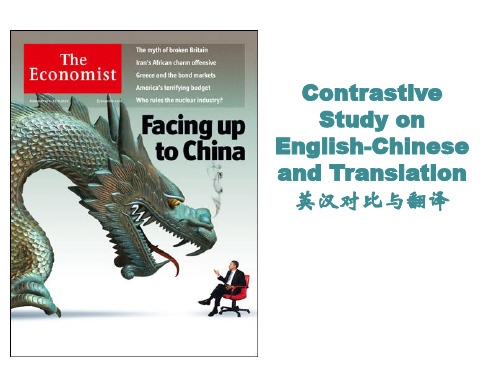
English Order of Linguistic Elements 英语语序
Relatively flexible order (语序相对灵活) resulting from the use of inflections and connectives Phrases:
the Russian people, the people of Russia, the people living in Russia, the people who live in Russia a pretty and clever girl a girl pretty and clever a girl who is pretty and clever
Chinese Order of Linguistic Elements
Order of logic <cause-effect, conditionresult> (逻辑顺序:因果,条件-结果) • 志同道合,友谊才会持久。 • 名不正则言不顺,言不顺则事不成。 • 天下雨,运动会延期了。 • 他爱睡懒觉,考试难过关。
我们看到很多住人的迹 象,当漫步街头走过一 个很大的棚户集中地, 离中央大道不远。
Hale Waihona Puke 我们漫步街头,在中 央大道附近发现了一 个很大的棚户区,有 很多迹象表明茅棚里 还住了人。
Pay attention to Chinese order of time and space.
Contrast Between English and Chinese
The position will not be given up so long as we are still living.
英汉对比与翻译-英汉词义对比
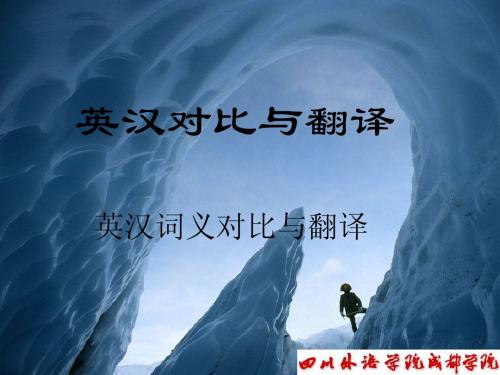
• • • • • • • •
蓝天白云 天高气爽 天下乌鸦一般黑 天字第一号 民以食为天 天庭 天涯 谋事在人、成事在天
• white clouds in a blue shy • The sky is clear and the air crisp. • All ravens under the sun are back. • Number one • Food the number one need of the people. • (the middle of) forehead • Horizon; the end of the world; the remotest place of the world
• 犬:dog, hound, • 走:walk, spaniel, mastiff, saunter, amble, pointer, setter, stride, trudge, retriever, terrier… shamble, prance, • carry: 搬、运、送、 scamper, clump, 提、拎、挑、担、 tiptoe … 抬、背、扛、搂、 抱、端、举、夹、 • 羊: sheep, 捧…… goat, ram, ewe, lamb…
• • • • •
物美价廉 cheap and good 个人主义 individualism/egotism 唯心主义 idealism 自由主义 materialism 红、黄、白
4)False friends ignorant of collocative meaning • 恶性循环 vicious circle • 恶性肿瘤 malignant tumor • 恶性通货膨胀 inflationary spiral/ galloping inflation • 恶性交通事故 grave traffic accident • 恶性贫血 pernicious anemia • 副(总统、经理、教授、司令、食 品、作用、标题) • Vice president deputy manager associate professor assistant commanding officer non-staple food side effect subheading
Unit 14教学重、难点讲解
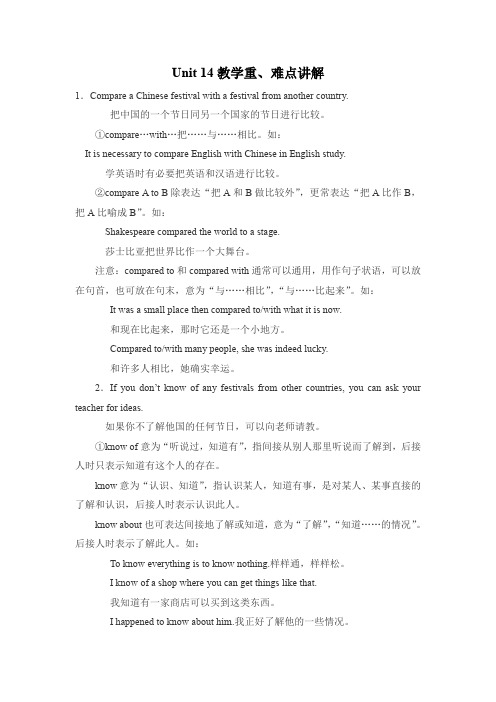
Unit 14教学重、难点讲解1.Compare a Chinese festival with a festival from another country.把中国的一个节日同另一个国家的节日进行比较。
①compare…with…把……与……相比。
如:It is necessary to compare English with Chinese in English study.学英语时有必要把英语和汉语进行比较。
②compare A to B除表达“把A和B做比较外”,更常表达“把A比作B,把A比喻成B”。
如:Shakespeare compared the world to a stage.莎士比亚把世界比作一个大舞台。
注意:compared to和compared with通常可以通用,用作句子状语,可以放在句首,也可放在句末,意为“与……相比”,“与……比起来”。
如:It was a small place then compared to/with what it is now.和现在比起来,那时它还是一个小地方。
Compared to/with many people, she was indeed lucky.和许多人相比,她确实幸运。
2.If you don’t know of any festivals from other countries, you can ask your teacher for ideas.如果你不了解他国的任何节日,可以向老师请教。
①know of意为“听说过,知道有”,指间接从别人那里听说而了解到,后接人时只表示知道有这个人的存在。
know意为“认识、知道”,指认识某人,知道有事,是对某人、某事直接的了解和认识,后接人时表示认识此人。
know about也可表达间接地了解或知道,意为“了解”,“知道……的情况”。
后接人时表示了解此人。
如:To know everything is to know nothing.样样通,样样松。
英汉对比与翻译(全)
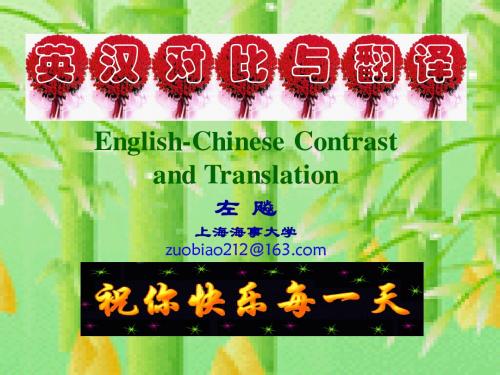
他不怕死。 He does not hear to die. fear
Examples of Negative Transfer
2、他一天只吃两顿饭。 He only eat two meal a day. eats meals 我去年到北京去了三次。 I go to Beijing 3 time last year. Went times Morphological transfer (词形迁移) 词形迁移) Neither nouns nor verbs have inflections in Chinese. 在汉语中,名词和动词都没有形态变化。
人到齐就开会。 The meeting will begin when all are here. 不要人云亦云。 Don’t say what others have said. Tense (时态) 帐单撕碎了。 The bill was torn to pieces. 问题解决了。 The problem was solved. Voice (语 态) 你再说一个字, If you should say one more 我马上走。 word, I would go at once. 你死了, If you should die, I would go and 我去当和尚。 be a monk. Mood (语气)
人在阵地在。 The position will not be given up so long as we are still living. 人无远虑, If one has no long-term considerations, 必有近忧。 he will find trouble at his doorstep.
Part One
汉英翻译基础教程第十四章
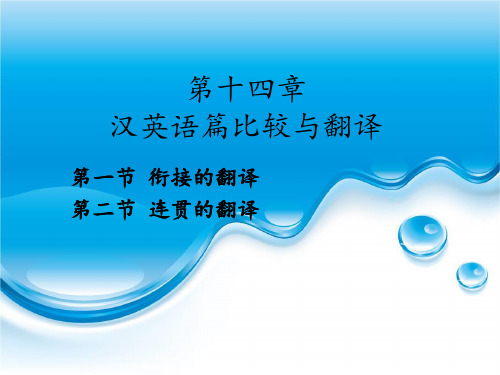
解净收起图说:“大家出车吧,下午 休息的时候再看(它),就贴在这里
Xie Jing folded up the diagram and said, "Now get moving. I’ll paste this up here and you can have a look at it during the midday break.”
He put his hands in his pockets and then shrugged his shoulders.
练习 我在(我的)书包里找到了(我的)钢笔。 I found my pen in my bag.
3 汉语的零前指VS.英语代词的补足
例子 朋友雨点不好意思地解释说,他买这座大 房子时,孩子们还在上着学,如今(他们) 都成家立业了 My friend looked somewhat ill at ease when he told me this :At the time when he bought this big house, his children had all been at school. Now they had their own homes and jobs.
3叙述思路的转换
现在,他正衔着旱烟管,扒在洞窟随手捡翻。他当然看不懂这些东西, 只觉得事情有点蹊跷。为何正好我在这儿时墙壁裂了缝呢?或许是神对 我的酬劳。趁下次到县城,捡几个经卷给县长看看,顺便说说这桩奇事。
• With a pipe in his mouth , Taoist Wang jumbled through his new discoveries in the cave. Of course, he didn’t know their value. He just felt it strange, thinking to himself, "Why did the wall break while I was here? It might be a reward for me from Heaven. Nest time I go to the county town, I'll show some of these to the county magistrate and tell him about this strange event.”
《汉英对比翻译》PPT课件.ppt

原文理解
My life has been lived in the healthy area between too little
and too much. I've never experienced financial or emotional
insecurity, but everything I have, I 've attainted by my own work, not through indulgence, inheritance or privilege. (C. Carroll: "
• satellite city;
fiscal income;
• to lay off somebody/laid-off workers;
• banquet hall;
Rare animal;
• laptop/notebook computer;
• enrollment;
garment company;
合同是二人或多人之间在相互间设定合法义务而达成的具有法律强制力的协议。有效
合同最基本的要素有:双方当事人或各方当事人在缔结合同时,必须具有缔约能力并
有缔结该合同的合法权限或授权,必须就其交易的全部条款达成了协议,通畅的方法
是通过交换要约或承诺;当事人的意图必须是为了建立在法律上具有强制力的合同,
而不是一个社交性或超法律的协议;协议在执行上不得有障碍,如协议的目标不能实
现,违法,如违反公共政策,以及其他不可强制执行的情况。在某些情况下,合同需 要一定的订立手续或证明,否则合同即不具有强制力,甚至导致合同完全无效。
• A contract is an agreement between two or more persons intended to create a legal obligation between them and to be legally enforceable . The essentials of a valid contract are that both or all parties must have at the same time of contracting had contractual capacity and legal power or authority to make the kind of contract contemplated , must have reached agreement on all the material terms of their bargain , normally by communication of offer and acceptance thereof , must have intended a legally enforceable , as distinct from a merely social or extra-legal agreement , and the agreement must not be objectionable as intended to effect an impossibility or anything illegal or contrary to public policy or otherwise unenforceable . In certain cases contracts require certain formalities of constitution or proof, without which they are unenforceable or even wholly void.
英汉比较与翻译(主要差异)教材

Subject prominent vs. Topic-prominent
英汉语言差异性特征对比
Synthetic vs. Analytic Hypotactic vs. Paratactic Compact vs. Diffusive Subject prominent vs. Topic-prominent Chronicle vs. Non-chronicle Stative vs. Dynamic
Feature o本没有形态变化,主要靠词语、词序及暗 含逻辑关系来表达句子的语言意义。
Practice
1.听到他这样讲话,我差点笑出来了。 I could have laughed to hear him talk like this. 2. The mountains began to throw their long blue shadows over the valley. 群山开始向山谷投下一道道蔚蓝色长影。 3. 李教授原打算在这干一辈子的,但还是由于种种原因去 了深圳。 Professor Li had planned to work here for the rest of his life, but now he has been to Shenzhen for reasons. 4.一群人立刻把他围住了,向他提出一个又一个问题。 Very soon he was surrounded by a crowd and was snowed under with questions.
Synthetic vs. Analytic 综合与分析
They told me that by the end of the year they would have been working together for thirty years.
- 1、下载文档前请自行甄别文档内容的完整性,平台不提供额外的编辑、内容补充、找答案等附加服务。
- 2、"仅部分预览"的文档,不可在线预览部分如存在完整性等问题,可反馈申请退款(可完整预览的文档不适用该条件!)。
- 3、如文档侵犯您的权益,请联系客服反馈,我们会尽快为您处理(人工客服工作时间:9:00-18:30)。
第14单元I 提示同第4单元II 译法要点5.1变通:OSV→SVO 5.2非谓语动词时态的语义色彩(I)5.3 互文性 5.4 直译:名词化形容词5.5 互文性:主题意象 5.6 互文性:普通名词与专有名词5.7创新:专有名词 5.8 译文的多样性:短语表达5.9误用:动词短语 5.10误用:状语的逻辑主语5.11非谓语动词的时态语义色彩(II) 5.12误用:动词5.13回译:后置时间状语从句 5.14矛盾修辞与Oxymoron5.15误用:虚拟语气结构 5.16呼应:语段中的时态5.17回译:互文词 5.18暗喻与Metaphor5.19 变通:合译(同位语从句)III 原文与译文【原文】向日葵(II)解放了,我到北京工作,这幅画却没有带来;总觉得这幅画面与当时四周的气氛不相合拍似的。
因为解放了,周围已没有落寞之感,一切都沉浸在节日的欢乐之中。
但是曾几何时,我又怀念起这幅画来了。
似乎人就像是这束向日葵,即使在落日的余辉里,都拼命要抓住这逐渐远去的夕阳。
我想起了深绿色的那面墙,它一时掩没了这一片耀眼的金黄;我曾经努力驱散那随着我身影的孤寂,在作无望的挣扎。
以后星移斗转,慢慢这一片金黄,在我的记忆里也不自觉地淡漠起来,逐渐疏远得几乎被遗忘了。
十年动乱中,我被谪放到南荒的劳改农场,每天做着我力所不及的劳役,心情惨淡得自己也害怕。
有天我推着粪车,走过一家农民的茅屋,从篱笆里探出头来的是几朵嫩黄的向日葵,衬托在一抹碧蓝的天色里。
我突然想起了上海寓所那面墨绿色墙上挂着的梵高的《向日葵》。
我忆起那时家庭的欢欣,三岁的女儿在学着大人腔说话,接着她也发觉自己学得不像,便嬉嬉笑了起来,爬上桌子指着我在念的书,说“等我大了,我也要念这个”。
而现在眼前只有几朵向日葵招呼着我,我的心不住沉落又漂浮,没个去处。
以后每天拾粪,即使要多走不少路,也宁愿到这处来兜个圈。
我只是想看一眼那几朵慢慢变成灰黄色的向日葵,重温一些旧时的欢乐,一直到有一天农民把熟透了的果实收藏了进去。
我记得那一天我走过这家农家时,篱笆里孩子们正在争夺丰收的果实,一片笑声里夹着尖叫;我也想到了我远在北国的女儿,她现在如果就夹杂在这群孩子的喧哗中,该多幸福!但如果她看见自己的父亲,衣衫褴褛,推着沉重的粪车,她又作何感想?我噙着眼里的泪水往回走。
我又想起了梵高那幅《向日葵》,他在画这画时,心头也许远比我尝到人世更大的孤凄,要不他又为什么画出行将衰败的花朵呢?但他也梦想欢欣,要不他为什么要用这耀眼的黄色作底呢?梵高的《向日葵》已经卖入富人家,可那幅复制品,却永远陪伴着我的记忆;难免想起作画者对生活的疯狂渴望。
人的一生尽管有多少波涛起伏,对生活的热爱却难能泯灭。
阳光的金色不断出现在我的眼前,这原是梵高的《向日葵》说出了我未能一表的心思。
【译文】译文1Sunflowers(II)After liberation I was transferred to Beijing to work and I failed to bring the picture with me. At that time I always felt that this picture did not suit with the surrounding atmosphere. For after liberation, I felt no loneliness but immersed and surrounded by happiness. Before long, I began to miss the picture again. It seems as if man is like this sunflower, even in his after-life he still struggles to grasp the departing sun. Thus, I thought of the dark green wall and felt it had absorbed this brilliant golden light for the time being. In vain, I struggled to drive away this lonely feeling which followed me like a shadow. With the lapse of time, the scene of golden yellow gradually faded in my memory and slowly became so estranged that it was almost forgotten.During the ten years of turmoil here I was sent to labour in a reform-through-labour farm in the south wasteland. Every day I toiled beyond my physical capacity and was so dismal at heart that I became afraid of it. One day, when I was pushing a dung-cart by a peasant’s hut , I noticed some tender yellow sunflowers stretching their heads over the fence into the vast blue sky. Sudd enly I was reminded ofVan Gogh’s “Sunflower” hanging on the dark green wall in my Shanghai flat. I could recall my family happiness then and my three-year-old girl who said something in imitation of a grown-up’s voice. When she found herself not good at do ing so, she burst out laughing. She bent down on the desk and said pointing to the book I was reading:”When I become a grown-up, I want to read this book, too.” Now, there were only a few sunflowers to greet me before my eyes and I felt upset at not knowing where to go. From then on, every day when I was collecting dung, I always took that same path. I didn’t mind if it meant a much longer distance. I only wanted to have a look at all the sunflowers which were gradually becoming greyish yellow and review my past happiness. One day the peasants collected the rip seeds and stored them away. I remember that day when I was walking past that peasant’s home, the children on the fence were snatching the harvest fruits. Amid their laughter I heard some sharp cries. I thought of my daughter who was living in the far north and how happy she would be if she was among those children and their joy! But if she saw her father pushing a heavy dung-cart in shabby clothes, what would she have thought of? I returned with my eyes full of tears. I again thought of Van Gogh’s painting “Sunflower”. Maybe when he was painting this picture, he was suffering a great loneliness. If not, how could he have painted such sunflowers which were going to fade? But he was too dreaming of happiness. If not, why did he use such a brilliant yellow colour as the thebottom?Van Gogh’s “Sunflower” has been sold to the rich, but that reproduction will always live in my memory. I can not refrain from thinking about the painter’s crazy desire towards li fe. In spite of the many twists and turns in life, one’s love for life will never be eliminated. The golden rays of the sun continuously appear before my eyes. This is what Van Gogh’s “Sunflower” has expressed what I did not say.译文2Sunflowers(II)After liberation in 1949 I was transferred to Beijing. I did not take the painting with me, as I felt that it was quite out of tune with the milieu of the time. In the liberated society we were immersed in a festival atmosphere and there was not slightest suggestion of loneliness. But soon I began to be missing the painting again. It seemed as if man, like this bunch of sunfloweres, would try to hang on to the setting sun in its afterglow. I thought of that dark green wall that seemed to have engulfed the brilliant yellow. I tried desperately to disperse the loneliness that followed me like a shadow but in vain. With the passage of time the golden yellow in my memory grew dim and gradually it was almost forgotten.During the chaotic ten years(1966-76) I was banished to a farm in Nanhuang to reform through labor. I was forced to work beyond my endurance and I was in such a gloomy state of mind that I often found myself scared. One day as I was pushing a dung-cart past a farmer’s thatched hut, I saw some fresh yellowish sunflowers, against a blue sky, craning out of its fence. They reminded me of the “Sunflowers” on the dark green wall in my house in Shanghai, calling back to mind the joys of the family: our three-year-old daughter was trying to speak the way adults do and, when she realized that her mimicking was funny, she giggled and then, climbing up to the desk and pointing to the book I was reading, said, “When I am grown, I will read this too .” But now in front there were only a few sunflowers nodding at me and my heart began to sink and float around, not knowing where to stop. Since then each time I went dung-collecting, I would go and pass that hut even if it meant more walk in the round of my daily journey. I wanted to see the sunflowers that were turning grayish yellow, reminiscing the cheerfulness of the days gone by, until one day the farmer got the crops in. When I passed the farmer’s hut that day, I heard some kids laughing and screaming over the fence, each trying to get a fair share of the seeds from the crops. I then thought of my daughter in the far north. How excited she would be if she were among the kids, making noises with them. However, if she had seen her own dad pushing the heavy dung-cart in the shabby clothes as they were, how would that have made her feel? I was on my way back with tears in my eyes and my thoughts turned to van Gogh and his “Sunflowers” again. When he was working on the painting, he might have felt more loneliness and misery of life, otherwise why did he paint the petals about to wither? However, I believed he had also dreamed of joy, or why should he have placed the petals against an intense yellow background?Now van Gogh’s “Sunflower” has become a rich man’s private property but that reproduction of the painting lives on in my memory, reminding me of the artist’s crazy lust for life. Though one has ups and downs to face down the road, his love for life is hard to fade away. That the golden color of the sunshine keeps popping up before my eyes is an in dication that van Gogh’s “Sunflowers” speaks for what I have been unable to bring out from my heart.IV 比较分析与译法(1)解放了,我到北京工作,这幅画却没有带来;总觉得这幅画面与当时四周的气氛不相合拍似的。
